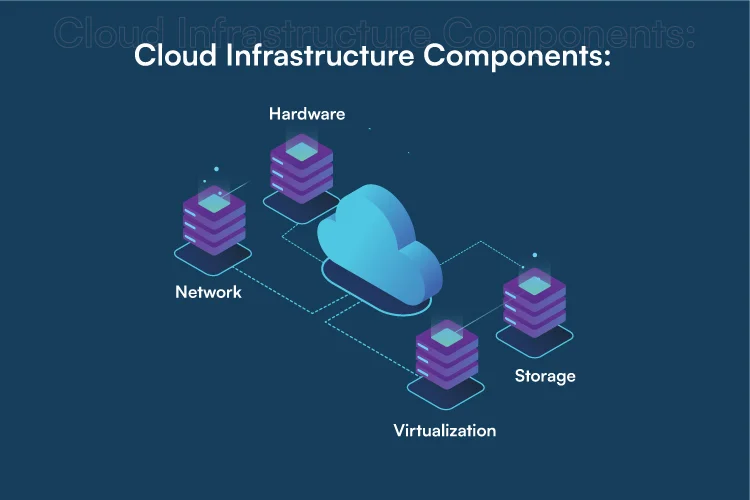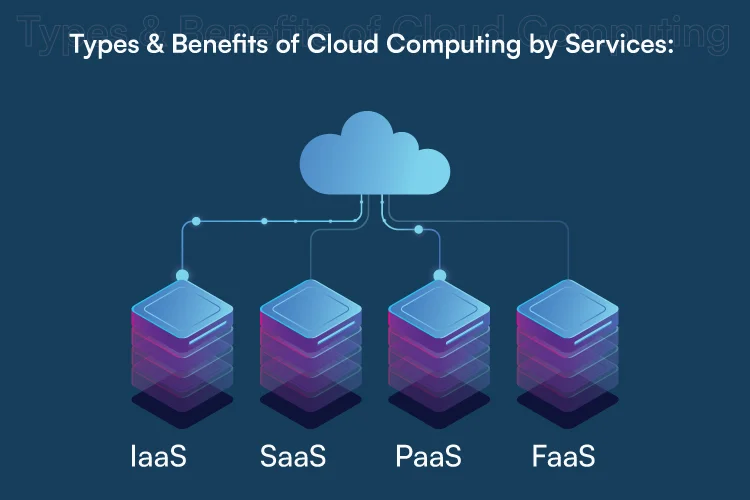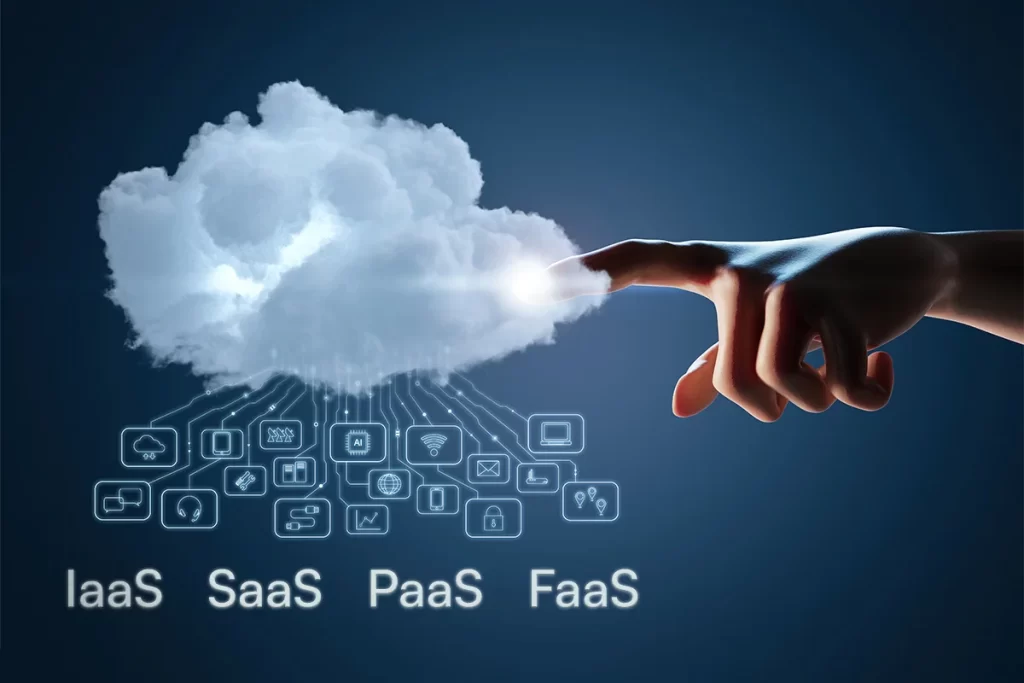People frequently use the terms IaaS, PaaS, FaaS, and SaaS interchangeably when discussing cloud computing because all of these technologies operate behind the cloud. These services, however, can be utilized by a wide range of industries, from healthcare to entertainment.
Cloud infrastructure services are third-party resources that allow access to the use of software, platforms, or infrastructure via the Internet in order to construct cloud-native apps or work more efficiently in the cloud. Data flow and exchange take place between the front-end user, who accesses services through devices such as PCs, laptops, mobile devices, or servers, and the backend or provider system.
IaaS, FaaS, PaaS, and SaaS are the primary subcategories of such cloud services that we will learn more about the cloud services in this blog.
What is Cloud Infrastructure?
The definition of a cloud infrastructure can be broad and complex. But, in the end, a cloud-based infrastructure consists of multiple critical components, and these components are a mix of network devices, software, and servers.
It is these components that are required to construct apps that may later be accessible via the cloud. Remote access to these apps is possible via the internet, telecom services, WANs (wide area networks), and other network mechanisms.
An EDI provider, for example, might offer its services via a cloud EDI software model, allowing clients to access the platform without having to maintain the necessary physical infrastructure on-premises.
Cloud infrastructure components:

Network:
The network is the communication channel that allows data to go from back-end cloud servers to front-end client devices. The computation takes place in an off-premises cloud data center. Users engage with these components via private or public networks that transmit data between the two ends of a cloud service. The data that is commonly transferred through the network includes visual information, logs, or control functionality.
The network is made up of physical electrical components like routers, lines, and switches, as well as software programs and hardware firmware that enable data exchange in accordance with the OSI data communications paradigm.
Hardware:
A group of virtual hosts that represent a preset set of real hardware components access cloud computing. While end users do not control, manage, or operate hardware at the physical layer, there is a set of hardware assets that are like each data center, whether cloud or on-premises. Servers, processor units, GPUs, power supplies, memory, and other components are examples of hardware components.
Storage:
A platform and storage system are an important part of the cloud infrastructure stack. Cloud data centers hold data across several storage types and devices, maintain backups, and expand storage allocation across users. Virtualization or a software-defined architecture abstracts the underlying hardware stack that supports the storage infrastructure. This enables customers to use storage as a cloud service that can be added or removed without having to manually supply hardware at each server as needed.
Virtualization:
Using virtualization or any software-defined computing architecture, the cloud service is separated from its hardware resources such as computing power and storage. A software system emulates hardware functions, giving users access to a virtual version of hardware resources such as platform, processing, storage, and networking.
Thus, the cloud vendors manage the hardware resources only to enable the cloud services. Users only pay for the services they use, hence hardware faults underlying a cloud service must not have an influence on the Service Level Agreement (SLA). These constraints are hidden from cloud service consumers thanks to virtualization, which allows IT workloads to be dynamically shifted and allocated across a pool of hardware resources available in virtualized and reconfigurable IT environments.
Role of Cloud Infrastructure in Cloud Computing:
By separating the features and activities of various hardware and software components, cloud infrastructure enables cloud computing. The virtualized resources are subsequently hosted by a cloud service provider or, in the case of a private cloud, by an IT department and made available to users over the internet or a network.
Types & Benefits of Cloud Computing by Services:

Below are detailed descriptions of cloud infrastructure services, together with their benefits and drawbacks, to help you understand the services and how the cloud works with them.
IaaS (Infrastructure-as-a-Service):
IaaS is known as one of the core services of cloud. The infrastructure as a service provider oversees the ‘physical end’ of the infrastructure as well as providing consumers with a virtualized infrastructure. IaaS users or customers can tailor the resources to their specific needs, including installing and administering software such as the operating system, middleware, applications, and other development tools. IaaS subscriptions allow businesses to simply pay for the resources they use, allowing them to scale as they develop without worrying about capacity management.
AWS (Amazon Web Services), CISCO Metacloud, Microsoft Azure, GCE (Google Compute Engine), and Rackspace are some popular IaaS providers.
Benefits of IaaS:
The major benefits of Infrastructure-as-a-Service are as follows:
- Cost-Effective: Eliminates capital expenses while lowering recurring costs, and IaaS users pay on a per-user basis, generally by the hour, week, or month.
- Website hosting: Using IaaS to host a website can be less expensive than traditional web hosting.
- Security: The IaaS Cloud Provider’s security may be superior to that of your present software.
- Maintenance: There is no need to manage the underlying data center or introduce new versions of the development or underlying software. The IaaS Cloud Provider handles all of this.
With such benefits for Infrastructure-as-a-Service hosting a website, underlying data center and software, while lowering recurring costs for the users it’s easy to pay and maintain the security of their software and data.
Working of IaaS:
The cloud service provider draws a plethora of hardware resources from numerous data centers and networks throughout the world. An underlying VM or hypervisor virtualizes all of these hardware resources. After that, the virtualized hardware resources are pooled and made available to the end user.
PaaS (Platform as a Service):
In the cloud computing pyramid, PaaS is higher than IaaS. PaaS suppliers are more specialized, providing the necessary foundation on top of pure infrastructure. The framework addresses the development, testing, deployment, management, and updating of various software products such as operating systems, development tools, middleware, and database management systems. PaaS enables enterprises, particularly those involved in web-based app and software development, to access the tools required for multi-platform development.
Microsoft Azure, AWS Elastic Beanstalk, Google App Engine, and Apache Stratos are examples of PaaS providers.
Benefits of PaaS:
- Users will find it simple and convenient: It supplies a large portion of the infrastructure and other IT services that users can access from anywhere using a web browser.
- Cost-effective: It charges for services given on a per-use basis, removing the need for on-premises infrastructure and software.
- Website development: It is meant to enable the entire web application lifecycle, including building, testing, deploying, managing, and updating.
- Efficiency: It enables higher-level programming with lower complexity, allowing for more effective application development overall.
Working of PaaS:
The Cloud Service Provider provides the infrastructure as well as the application that is hosted on it. PaaS comprises the basic IaaS layer as well as runtimes (such as Java runtimes), databases (such as My SQL and Oracle), and web servers (such as Apache TomCat).
Cloud infrastructure services are provided on-demand for the development, testing, delivery, and management of software applications. PaaS is intended to make it easier for developers to construct applications or mobile apps without having to worry about setting up or managing the underlying infrastructure of servers, storage, networks, and databases.
SaaS (Software as a Service):
It refers to the execution of the entire application on the cloud provider’s infrastructure, which further limits the customer’s degrees of freedom in comparison to PaaS and IaaS. One of the primary benefits of SaaS is that the cloud provider handles the entire software lifetime. However, if the client is limited by the set of accessible features and the composition of SaaS services, it is typically not viable to construct an innovative application.
Benefits of SaaS:
- Cost-Effective: Users save time because most SaaS programs may be run immediately from their web browser without the need to download and install any software. This decreases the time spent on installation and configuration, as well as the complications that may arise during software distribution.
- Accessibility: Have access to app data from any location.
- Automatic updates: Customers rely on a SaaS provider to automatically perform upgrades rather than purchasing new software.
- Scalability: It enables users to access services and features as needed.
As we read that SaaS handles the entire software lifetime and the benefits also state that SaaS is accessible from any location and provides automatic updates, making it easier for users to install any software from any location.
Working of SaaS:
SaaS tightly offers business software to thousands of customers via what is known as multitenant architecture. The cloud component merely denotes an active internet connection as well as the devices and browsers that allow access.
All the elements that define a software, such as scripts, codes, and algorithms, as well as the physical hardware in the form of servers and the structures that house them, are kept and maintained by the vendors in their own facilities, indicating a significant shift in how deployment is carried out, as previously mentioned.
On the customer side, there is no upfront investment in servers or software licensing; on the provider side, expenses are reduced compared to traditional hosting because there is only one app to operate.
Best SaaS Applications 2023:
The best SaaS application of 2023 are listed down below:
- SonarCloud
- TaskClone
- Databox
- Deskera
- PickFu
FaaS (Function as a Service)
Function as service providers is even less complicated than PaaS. It is an event-based architecture since it is based on functions that can be triggered by a specific event. It is so simple that it is referred to as a serverless architecture. The developer only must type a function here and does not have to think about deployment, server resources, or scalability. As a result, Function as service providers is self-scaling.
Examples of FaaS are, AWS Lambda, Google Cloud Functions, Microsoft Azure Functions, Iron.io, and Webtask.io.
Benefits of FaaS:
- Highly Scalable: The supplier scales automatically based on demand.
- Cost-effective: You only pay for the number of events that are completed.
- Code Simplification: With FaaS, users can upload the entire application at once. It enables you to write code for independent functions or functions that are comparable to those functions.
- Code maintenance: It is sufficient, and there is no need to be concerned about servers.
Working of FaaS:
Developers under this paradigm are only concerned with writing functions and are not concerned with infrastructure or service-related computation.
When these functions are invoked, the cloud provider brings up the server, and when the function is successfully executed, the server is shut down. The Function is invoked, these servers become accessible on demand and remain unavailable until the Function is complete. As a result, the cloud service subscriber saves money.
Conclusion:
Companies are shifting to cloud architecture to help in the event of a disaster. By copying your data from the surviving data centers, cloud computing can aid in disaster recovery. Another reason is accessibility, scalability, automatic software updates, and the flexibility to operate from any location (Github). The service models we mentioned earlier have significantly streamlined cloud computing.
Cuneiform Consulting Pvt. Ltd., as a cloud computing service provider, deals with all the services and assists enterprises in achieving the best outcomes for their websites.
You don’t have to limit yourself to a particular service because you can utilize any of these as needed. As a result, we hope the information in this blog will assist you in making more educated decisions about cloud computing services.




